Content for TR 22.951 Word version: 18.0.1
0 Introduction
1 Scope
2 References
3 Definitions, symbols and abbreviations
4 General Aspects
5 Network Sharing Scenarios
6 Network Identities and User Classification
7 User Requirements
8 Network requirements
9 Mobility Requirements
10 Security Requirements
11 Charging Requirements
12 Conclusions
...
...
0 Introduction p. 4
Network sharing is becoming more and more popular as a means to provide coverage quickly and in a cost efficient way. The high price paid for the license in some countries as well as mergers, acquisitions have raised recently high interest in this topic. For these reasons 3GPP has decided to investigate what shortcomings currently in the technical specifications may prevent a standardized approach to the deployment of shared networks. This TR is aimed to describe a wide variety of possible network sharing and highlight the expected user experience for each of the scenarios. Charging aspects, terminal aspects and security are also investigated.
The purpose of this technical report is to collate in a single document the requirements, considerations and deployment scenarios that operators as well as users need to see fulfilled for a successful use of a shared network. Particular attention has been given in making possible the avoidance of proprietary solutions particularly for what concerns the terminals.
Furthermore, the concepts discussed in this report may be applied to sharing a GERAN and UTRAN infrastructure, in this sense the interest in network sharing tools extends to the vast majority of the existing GSM operators who intend to deploy a UMTS Terrestrial Radio Access Network layer to complement the existing GSM/GPRS coverage.
1 Scope p. 5
In the current dynamic market place, as a result of partnerships, acquisitions, creative agreements among operators and so on, the need for tools that enable various degrees of network sharing is becoming more and more important.
When GSM and then UMTS were specified, the possibility of sharing part or all of the network by two or more separated commercial entities was not considered and as a result the standards lack some functionalities that enable the realisation of such commercial agreements.
GSM was designed under the principle "one operator, one radio access network". The GSM network has some possibilities of infrastructure sharing, but it does not support true radio access network sharing. The initial design of 3GPP system has followed the same principle.
This technical report is aimed to capture the service and user requirements that must be fulfilled by the 3GPP system in order to enable network sharing in a standardised way. Section 5 describes various Network sharing includes various scenarios e.g. spanning from common radio access network connected to multiple core networks toor multiple radio access networks sharing one core network. Section 6 contains a summary of the user classification and network identities. In section 7 the user requirements are described, while section 8 deals with the network operator requirements. Section 9 describes the mobility requirements in a shared network. The rest of the document is covering security (section 10) and charging (section 11). Some conclusions can be found in section 12 and an annex with examples of practical realisation of network sharing is provided.
2 References p. 5
The following documents contain provisions which, through reference in this text, constitute provisions of the present document.
- References are either specific (identified by date of publication, edition number, version number, etc.) or non-specific.
- For a specific reference, subsequent revisions do not apply.
- For a non-specific reference, the latest version applies. In the case of a reference to a 3GPP document (including a GSM document), a non-specific reference implicitly refers to the latest version of that document in the same Release as the present document.
3 Definitions, symbols and abbreviations p. 5
3.1 Definitions p. 5
Core Network Operator:
Operator that offers core network services.
Iu-flex:
Routing functionality for intra domain connection of RAN nodes to multiple CN nodes.
Radio Access Network Operator:
Operator that offers radio access to one or more core network operators.
RAN sharing:
Two or more CN operators share the same RAN, i.e. a RAN node (RNC or BSC) is connected to multiple CN nodes (SGSNs and MSC/VLRs) belonging to different CN operators.
Roaming:
The ability for a user to function in a serving network different from the home network. The serving network could be a shared network operated by two or more network operator.
Shared Network:
When two or more network operator sharing network elements.
3.2 Symbols p. 6
3.3 Abbreviations p. 6
For the purposes of the present document, the following abbreviations apply:
4 General Aspects p. 6
Void
5 Network Sharing Scenarios p. 6
Sharing networks and network infrastructure has become a very important part of 3GPP systems. There are many network-sharing scenarios possible depending on different operator strategies but also on rules and legislation in different countries. 3GPP systems are originally not fully designed for network sharing between different operators however some limited support exists in the 3GPP Release 99.The equivalent PLMN feature in Release 99 allows operators to share a common UTRAN, with certain parts of the core networks also shared between the operators, see Figure 1.
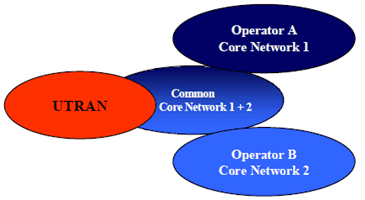
Figure 1: Two operators sharing the same UTRAN. To make this work, parts of the core network need to shared as well.
(⇒ copy of original 3GPP image)
(⇒ copy of original 3GPP image)
Important to note here is that this network-sharing scenario allows operators without a UMTS license to share the network and supply its customers with 3G services. For example, a 2G operator may supply its subscribers with 3G services using another operator's allocated spectrum. A geographically split network, i.e. a scenario in which cooperating operators cover different parts of a country, is also possible in Release 99. One operator's core network may also be connected to several UTRANs, see Figure 1.
Different kinds of evolution paths are essential for shared networks. For example, it is not only the sharing solution at a certain time that is important, but also how it is possible for the sharing partners to evolve either to a more dedicated network or to a more joint network. That is, the set of infrastructure sharing solutions and scenarios that is discussed in the industry cover alternatives that together include:
- solution alternatives targeting at dedicated networks in the near future,
- solutions for infrastructure sharing not targeting at immediate exit, but at exit when for example the network capacity demand so requires,
- infrastracture sharing targeting at long term sharing, which for example is the case when one of the operators lacks a frequency license.
5.1 Scenario1: Multiple core networks sharing common radio access network in R99 p. 7
For operators that have multiple frequency allocations it is possible to share the RAN elements, but not to share the radio frequencies. In this case the operators connect directly to their own dedicated carrier layer in the shared RNC in the shared RAN. This solution is possible with 3GPP Release 99 and is illustrated below in Figure 2 for the case when two operators have one license each.

Figure 2: The figure illustrates how it is possible to within the 3GPP Release 99 framework have dedicated carrier layers in the RAN for multiple operator. The operators transmit their own mobile network code (MNC) on their dedicated carrier
(⇒ copy of original 3GPP image)
(⇒ copy of original 3GPP image)
5.1.1 Limitations p. 7
FFS
5.2 Scenario 2: Geographically split networks sharing p. 7
In this scenario, two (or more) operators with individual 3G licenses will with their respective radio access networks cover different parts of a country but together provide coverage of the entire country.
This scenario can be divided into following cases:
- When two (or more operators) employ national roaming for the users, which implies that only one core network will be associated with each radio access network. Care is obviously needed when coverage regions overlap, which makes this a valid shared-networks scenario. This case is shown in Figure 3.
- The operators can have their individual core networks connected to both radio access networks throughout the entire coverage area, but utilizing the different operator's allocated spectrum in different parts of the coverage area. There will thus be multiple core network operators in each of the shared radio access networks. The connection of the core networks to the radio access networks can either be done by connecting the radio network controllers to both operators' core network elements or by sharing parts of the core network, e.g. SGSNs and/or MSCs. The work on shared networks in Rel-6 should not make any of these possibilities mandatory and it should be the choice of the operator which one is implemented. Additionally it should, be possible to introduce Iu-flex functionality between the common core network parts and the radio access network for purely load-sharing purposes.
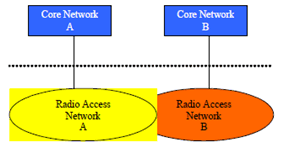
Figure 3: Geographically split network using national roaming between operators.
(⇒ copy of original 3GPP image)
(⇒ copy of original 3GPP image)
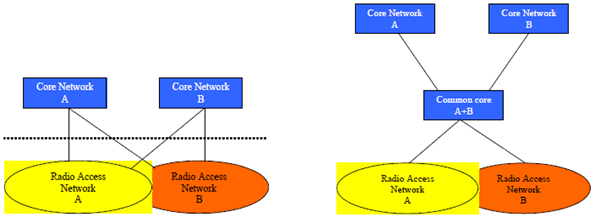
Figure 4: Geographically split shared radio networks scenarios with dedicated or common core networks
(⇒ copy of original 3GPP image)
(⇒ copy of original 3GPP image)
The national roaming scenario and the common core network scenario in Figure 4 can be deployed already today using R99 functionality and are therefore important in the future work of 3GPP. The scenario with dedicated core networks in Figure 4 is not supported by Rel-5 specifications.
In areas where more than one of the operators provide coverage, it should be possible to restrict the access rights so that the users are only allowed to use the radio access network provided by their home operator.
5.3 Scenario 3: Common Network Sharing p. 8
In this scenario, one operator will deploy coverage in a specific geographical area, and other operators will be allowed to use this coverage for their subscribers. Outside this geographical area, coverage is provided by each of the operators.
For example, in the case of two operators, a third-party could provide UTRAN coverage to operators A and B' subscribers in areas with high population density. In less dense areas, GERAN coverage is provided by operator A and operator B and in these areas the subscribers should connect to the access network of their operator.
5.4 Scenario 4: Common spectrum network sharing p. 8
Common spectrum network sharing is applicable when
- one operator has a 3G license and shares the allocated spectrum with other operators.
- a number of operators decide to pool their allocated spectrums and share the total spectrum (operators without allocated spectrum may also share this pooled spectrum).
- Connecting each operator's core networks and to the shared radio access network(s), see case 1 in Figure 5 below (only 1 radio network controller for simplicity). In this case it should be possible that one or more of the core network operators use Iu Flex between their core network and the shared radio access network. The technical realisation of this scenario may reuse some of the mechanisms already specified in REL-5 Iu Flex. Described in the figure below are three network operators, A, B and C. Operators A and C are not using multiple core network nodes (CN) and therefore may not need to use Iu-Flex. Operator B is using multiple CNs and has decided to use Ie-Flex to enable the intra-domain sharing of CNs
- The core network entities connected to radio access network can be shared, see case 2 in Figure 5 below.
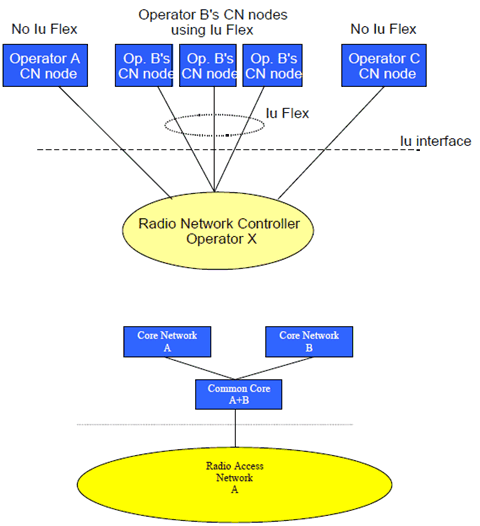
The work on shared networks in Rel-6 should not make any of these possibilities mandatory and it should be the choice of the operator which one is implemented.
5.5 Scenario 5: Multiple radio access networks sharing common core network p. 9
In this scenario multiple radio access networks share a common network. The multiple RANs can belong to different PLMNs and network operators. Due to operators' deployment different nodes or part of the common core network i.e. HSS/HLR, SGSN etc can be shared.
The scenario is depicted in the Figure below:
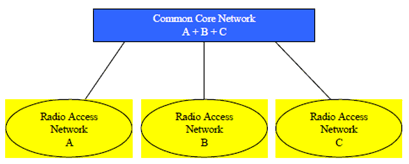
6 Network Identities and User Classification p. 10
To fully support for example handover, service differentiation and access rights in shared networks it is occasionally necessary to identify to which operator that a user belongs to and possibly group the users according to this information. To avoid complicated operation and maintenance procedures, such user classification should be general for all the functions in the shared network that needs information about the user identity.
7 User Requirements p. 10
Network sharing is an agreement between network operators and is transparent to the user.
7.1 Network selection p. 10
When network sharing exists between different operators and a user roams into the shared network it should be possible for that user to register with a core network operator (among the network sharing partners) that either
- the user has a subscription with, or
- the user's home operator has a roaming agreement with,
7.2 Network name display p. 10
The terminal always displays the name of the core network operator the user has registered with. It should be noted that for pre-Rel-6 UEs the network name display for roaming users in Scenarios 2 and 4 are not supported.
7.3 UE requirements p. 10
A Rel-6 network sharing solution should support legacy (pre-Rel-6) UEs. This requirement is important since a Rel-6 network sharing solution may imply changes in the UEs.
Without changes to pre-Rel 6 specifications, pre-Rel-6 UEs may in certain cases not be able to support the full set of Rel-6 enhancements. The following two cases have currently been identified:
- Manual network selection for roaming users in Scenario 2 and Scenario 4.
- Network name display for roaming users in Scenario 2 and Scenario 4.
8 Network requirements p. 11
The service capabilities and requirements should not be restricted by network sharing scenarios.
It should be possible for a network operator to differentiate its service offering from other network operators within shared network.
The services and service capabilities offered should not be restricted by the existence of network sharing.
It should be possible for a network operator to differentiate its service offering from other network operators within shared network.
The provision of services and service capabilities that is possible to offer in a network should not be restricted by the existence of the network sharing It should be possible for a core network operator to differentiate its service offering from other core network operators within the shared network.
It should be possible to control the access to service capabilities offered by a shared network according to the core network operator the user is subscribed to.
9 Mobility Requirements p. 11
9.1 Service continuity p. 11
The mobility in a shared network, both when controlled by the UE and when controlled by the network should not cause any undue interruption of service.
It should be possible for a subscriber to roam between the different parts of a shared network without requiring the user intervention. The user experience while roaming in a shared network should be no worse than the user experiences in a non-shared network.
9.2 Handover p. 11
Seamless handover should be supported between a shared network and a non-shared network. The user should be able to receive the same service level during and after a handover between the networks.
The network should be able to access the relevant subscriber information in order to determine the appropriate candidate for handover. Examples of information that may be required in order to take the decision on the candidate could include (non exhaustive list):
- type of subscription (e.g. prepay / postpay)
- home network of the subscriber (for roaming subscribers)
- service(s) to be handed over
- subscribed quality of service
9.3 Roaming p. 11
When the user is registered on a shared network, the control of the PLMN and radio access technology (e.g. UTRA, GERAN) employed within that shared network is under the sole control of the network operator. This does not imply any limitation on the manual or automatic selection of a PLMN that does not belong to the shared network where the user is registered.
The standards should specify mechanisms necessary to enable flexible allocation of inbound roamers among core network operators that have roaming agreements with the same roaming partners. The core network operators should be able to pre-define their relative share of inbound roamers and the network should distribute the inbound roamers that apply automatic network selection to different core networks connected to the radio access network accordingly. It should also be possible for the core network operator to allow or force the subscribers to reselect to another part of the shared network so that the relative share of inbound roamers is maintained.
In case the mobility in the shared network is controlled by the UE (e.g. cell reselection) the operator should be able to set parameters, other than radio parameters that determine the most appropriate candidate. Examples of these parameters are: subscription information, requested service, network load and so on.
10 Security Requirements p. 12
FFS
11 Charging Requirements p. 12
Charging solutions should support the shared network architecture so that both end users and network sharing partners can be correctly charged for their usage of the shared network.
12 Conclusions p. 12
This technical report has identified various scenarios, service and user requirements that should be fulfilled by 3GPP specifications in order to enable network sharing. The functionalities needed to enable network sharing in a standardized way will be added to existing or new specifications. Chapter 12.1 is a non-exhaustive list of the affected specifications. It is concluded that the further work in other groups within 3GPP on the requirements identified in this technical report is carried out.
12.1 Impacts on 3GPP Specifications p. 12
FFS